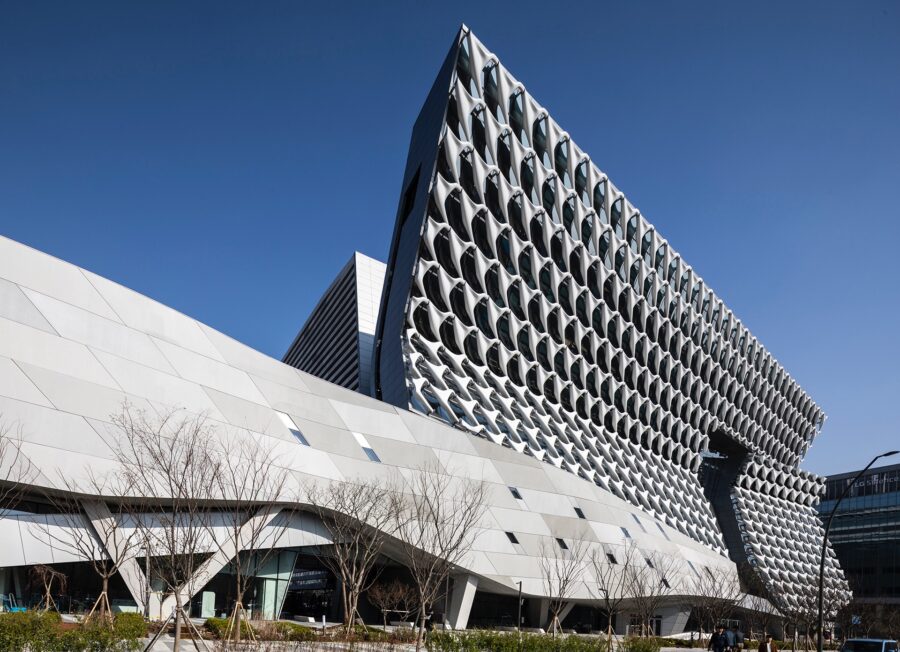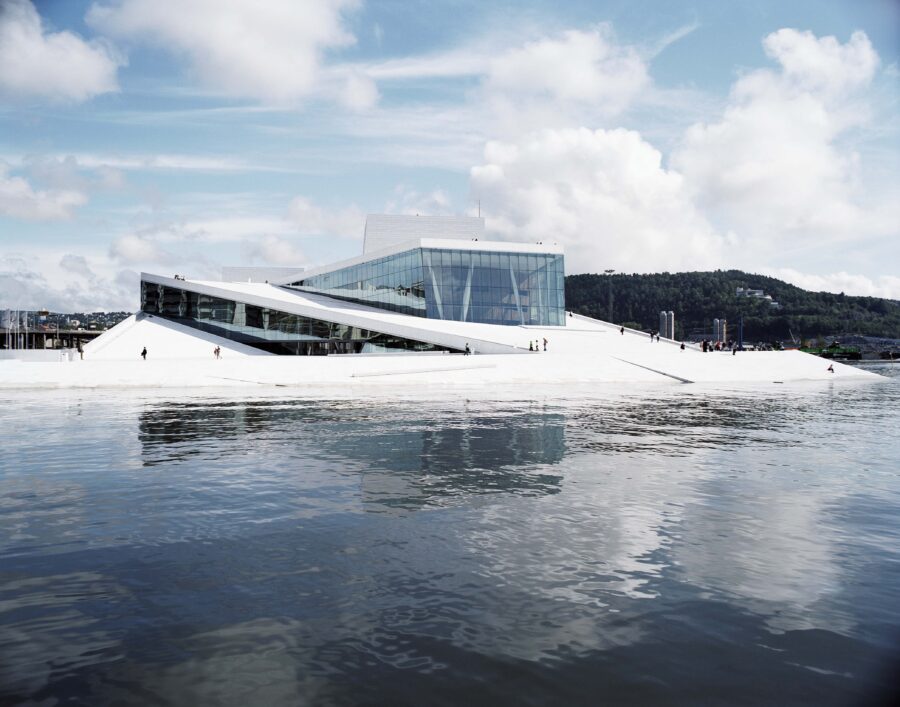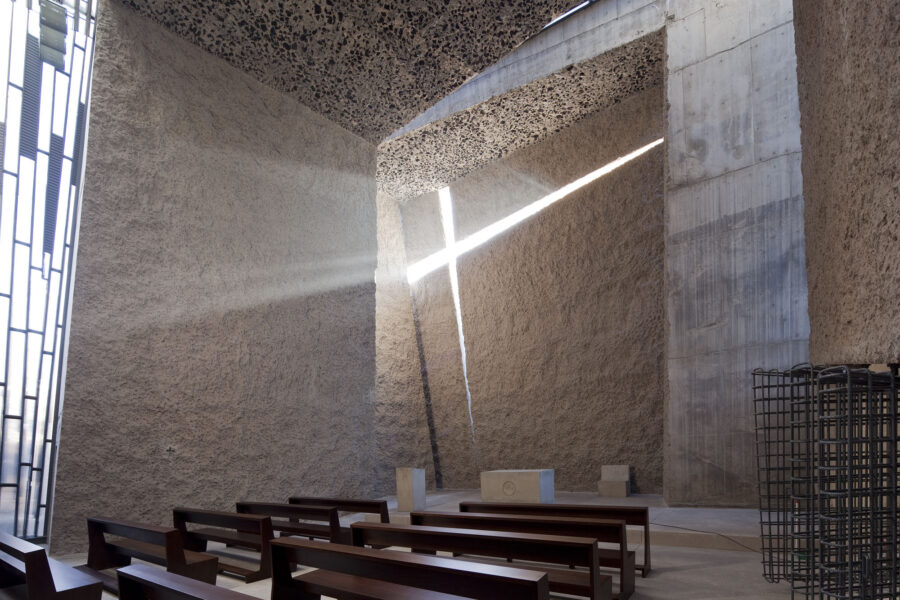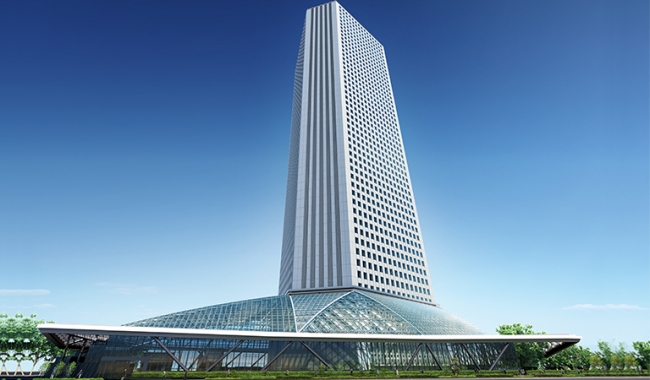
CULTURE


Existing © Ostrava city archive
チェコのオストラバに建つ〈PLATO コンテンポラリー・アート・ギャラリー(PLATO Contemporary Art Gallery)〉は、古くから建つ老朽化した食肉処理場を改修した現代アートのためのギャラリーです。建物の老朽化により生じた開口部を回転壁に置き換えることで、オリジナルの外観を維持しつつ展示ホールを直接周辺へと開放します。
ポーランドを拠点に活動する設計事務所 KWK PROMESが設計した、近年、海外建築業界で注目を集めている、歴史的な建築物を保存するだけでなく現代に適合させ活用する「アダプティブリユース」という考え方を取り入れた建築です。
(以下、KWK PROMESから提供されたプレスキットのテキストの抄訳)

© Juliusz Sokołowski

© Juliusz Sokołowski

© Jakub Certowicz
老朽化による開口部からアートを直接まちに開くアートギャラリー
〈PLATO コンテンポラリー・アート・ギャラリー〉は、チェコの都市オストラバに古くから建つ老朽化した食肉処理場を、現代アートのためのギャラリーに改装する国際コンペティションから実現した。食肉処理場の壁は老朽化し、あちこちに大きな穴が開き、すすけたレンガはこのまちの産業の歴史を物語っていた。
私たちはこれらの欠陥をそのまま受け止めつつ、建物の歴史に新たなレイヤーを加えた。

© Juliusz Sokołowski

© Juliusz Sokołowski
私たちは、特徴的な汚れたレンガや窓、壁の古い装飾を残しながら、開口部を現代的な材料で埋めることとした。また、マイクロ・セメント(編集部註:さまざまな表面に薄く塗布できるセメントベースのコーティング)により着工時には無くなっていた建物の一部を再建した。
このプロジェクトの主なアイデアは、建物とまちをつなぐ近道として開口部の機能を維持することにある。そこから、新しい要素が回転することで展示ホールを直接外に開くというアイデアが生まれた。これにより、アーティストやキュレーターはまったく新しい展示の可能性を手に入れ、アートは建物周辺の空間に出て行くことができるようになった。この可動性は、広い意味での文化がより民主的になり、新たな観客がアクセスできるようになる機会を意味する。

Existing © KWK PROMES

© Jakub Certowicz
建物とまちをつなげることで生まれたエクステリアデザインの必要性
私たちは、かつての食肉処理場の建物の保存だけでなく、本来は私たちの仕事ではなかった屋外エリアのデザインにも関わることとなった。
当初、私たちはアート活動のために舗装された場所を想像していたが、オストラバをよく知るにつれ、この場所には住民のための魅力的な緑地がもっと必要であることに気がついた。

© Juliusz Sokołowski

© Jan Antos
そこで私たちは汚れた土壌を修復し、透水性の床、花畑、貯水池を備えた生物多様性のある公園に生まれ変わらせた。
緑のレイアウトは、かつて食肉処理場を支えていた建物の位置を参考にしており、ギャラリー内にも食用作物が植えられている。これによりアートだけでなく環境問題にも配慮した、包括的な空間が誕生した。

© Dita Eibenova
既存の雰囲気を維持する補修要素
オリジナルの建物における主要なマテリアルはレンガである。そこで劣化したレンガのほとんどは、建物の崩壊した部分から回収されたもので補うこととした。新しい窓ガラスにはセラミック・スクリーン・プリントを施すことで暗くくすんで見え、ギャラリー内の光を減衰させる。
食肉処理場の内部は衛生上の観点から石灰で白く塗られていたため、展示ホールはミネラルボードの断熱材の上に白い石灰漆喰が塗られている。建物内部の汚れたレンガ造りは、かつてのアトリウムに現れており、 すべてのギャラリー・スペースをつなぐ架け橋となっている。

© Jakub Certowicz

© Juliusz Sokołowski
オリジナルの装飾を維持することで、回転しつつも密閉性を確保するマイクロ・セメントの壁
黒いフェルトで覆われていた木造の屋根は老朽化していたため、鉄骨の構造体に置き換え、明るい色の防水皮膜で覆うことで屋根の熱を下げている。この色は、マイクロ・セメントでつくられた新たな要素や改築された要素と呼応している。
マイクロ・セメントの要素の中で最も重要なものは、6つの回転壁である。その内の2つは建物へのエントランスであり、他の壁はギャラリーと周辺空間をつなぎ、壁を閉じると展示エリアの延長となる。

© Jakub Certowicz

© Jakub Certowicz
既存の装飾を残すことは、非常に現実的な解決策であった。
それは、レンガ壁の厚さの違いに門を合わせることができたからであり、かなりの大きさにもかかわらず、閉じれば完全に密閉することができる。床下に隠された機構は、メンテナンスは年に1度だけと容易である。
タワー部分は、建物の運営に関連する設備が設置されていた場所である。歴史的なファサードや平滑な屋根を邪魔しないよう、本来の機能を維持している。

© Jakub Certowicz

© Jakub Certowicz

© Jakub Certowicz

© Juliusz Sokołowski

© Juliusz Sokołowski

© Juliusz Sokołowski

© Jakub Certowicz

© Jakub Certowicz

© Juliusz Sokołowski

© Jakub Certowicz

© Jakub Certowicz

© Jakub Certowicz








以下、KWK PROMESのリリース(英文)です。
PLATO Contemporary Art Gallery
By saving a historic building and turning it into an art gallery, we introduced a solution that makes art more democratic. Thanks to the revolving walls, it goes outside the building in an unusual way. We transformed the space around the gallery, which was previously contaminated, into a biodiverse art park for the benefit of the residents.
GENESIS + IDEA
The realization is the result of an international competition to transform a dilapidated old slaughterhouse in the Czech city of Ostrava into the PLATO Gallery of Contemporary Art. The walls of the slaughterhouse were dilapidated and battered in many places by huge holes. The sooty brickwork bore witness to the city’s industrial history. We took these deficiencies at face value and added another layer to the history of the building, which is under conservation protection. We were allowed to preserve the character of the soiled brick and the windows, and to fill in the openings in the walls with contemporary material while retaining the old ornamentation of the brick walls. We also used the principle of recreating all the non-existent elements of the building from micro-concrete to rebuild a section of the slaughterhouse that did not survive the start of construction.
The main idea of the project is based on preserving the functionality of the openings as shortcuts connecting the building to the city. Hence the idea that their new infills could rotate and open the exhibition halls directly to the outside. This has provided artists and curators with entirely new exhibition possibilities and allows art to literally ‘go out’ into the space around the building. Mobility has meant that culture in the broader sense has the opportunity to become more democratic, as well as accessible to new audiences.
We became involved not only in saving the former slaughterhouse building, but also in the design of the outdoor areas, even though this was not our task. Initially, we imagined a paved surface there for artistic activities, but as we got to know Ostrava better, we realised that the place was more in need of attractive green space for residents. The contaminated soil there has been rehabilitated and replaced by a biodiverse park with water-permeable floors, flower meadows and with retention basins. The layout of the greenery refers to the location of the buildings that once supported the slaughterhouse, and edible crops, also inside the gallery, complete the transformation of the site. An inclusive space has been created, sensitising not only to art but also to environmental issues.
The life of the park is a process that has been planned over the years, going on in a sense on its own terms. Although we don’t really have any influence on its final appearance, we have seen great value in what has happened here. A community of people has formed around the gallery, actively participating in the process of creating it, and we have come to understand that by giving the field to others, there is a real commitment to be gained. The typical sterility here has been replaced by an engaging aesthetic, where process and participation are paramount. This also applies to the interior of the gallery, which largely lives its own life, making this elitist function much more egalitarian.STRUCTURE
The original, dominant material of the building is brick (of which it was built). The deteriorated bricks have been mostly replenished with those recovered from a collapsed section of the building. The new glazing has a ceramic screen print, making it appear dark and dull, attenuating the light in the galleries. The abattoir’s interiors were whitewashed with lime for hygienic purposes, so the exhibition rooms are finished with white lime plaster laid over mineral board insulation. The soiled brickwork inside the building appears in the former atrium, which, after roofing, became the link between all gallery spaces. The wooden roofs covered with dark felt have deteriorated and have been replaced with steel structures and covered with a light-coloured membrane. As a result, the roofs heat up less, without creating a heat island effect around them. The colour refers to the micro-concrete from which all the new and reconstructed elements are made. The most important of these are the six rotating walls, two of which are entrances to the building and the others connect the galleries to the surroundings. When closed, the walls become an extension of the exhibition area. Retaining the ornamentation proved to be a very pragmatic solution, as it allowed the gates to adapt to the varying thickness of the brick walls. Despite their considerable size, when closed they provide a complete seal, and servicing the mechanisms hidden under the floor is simple and required once a year. The tower was the location of installations related to the operation of the slaughterhouse. We have retained its original purpose so that the installation elements do not interfere with the historic facades and smooth roofs.
EPILOGUE
During the redevelopment, the PLATO gallery was temporarily housed in the neighbouring Bauhaus building – a former DIY store. With the abandonment of the Bauhaus comes the question of its future and how to deal with such buildings. We decided that we would fight for this space in the same way that we fought for the space around the former slaughterhouse. That is why we started a long process, similar to the one initiated many years ago to save the buildings of the revitalised slaughterhouse.
PROJECT CREDITS:
office: Robert Konieczny KWK Promes
social media:
Facebook: KWK Promes, Robert Konieczny
Instagram: @kwkpromes, @robertokoniecznyauthors: architects Robert Konieczny, Michał Lisiński, Dorota Skóra
author cooperation: architects Tadeáš Goryczka, Marek Golab-Sieling
collaboration: architects Agnieszka Wolny-Grabowska, Krzysztof Kobiela, Adrianna Wycisło, Mateusz Białek, Jakub Bilan, Wojciech Fudala, Katarzyna Kuzior, Damian Kuna, Jakub Pielecha, Magdalena Orzeł – Rurańska, Elżbieta Siwiec, Anna Szewczyk, Kinga Wojtanowska, Karol Knap
Structural engineers: MS – Projekce Ing. Jaroslav Habrnal, Ing. Petr Hanko
Building services engineers: MS – Projekce Ing. Jaroslav Habrnal, Ing. Petr Hanko
Landscape architect: Denisa Tomášková
Interior design: Robert Konieczny KWK Promes, TUKEJ Justyna Kucharczyk, Agnieszka Nawrocka, Yvette Vašourková CCEA MOBAClient: Statutory City of Ostrava
Site area: 11417.50 m²
Gross floor area: 3601 m²
Usable floor area: 2841 m²
「PLATO Contemporary Art Gallery」KWK PROMES 公式サイト
https://www.kwkpromes.pl/en/plato-contemporary-art-gallery-2/16788









